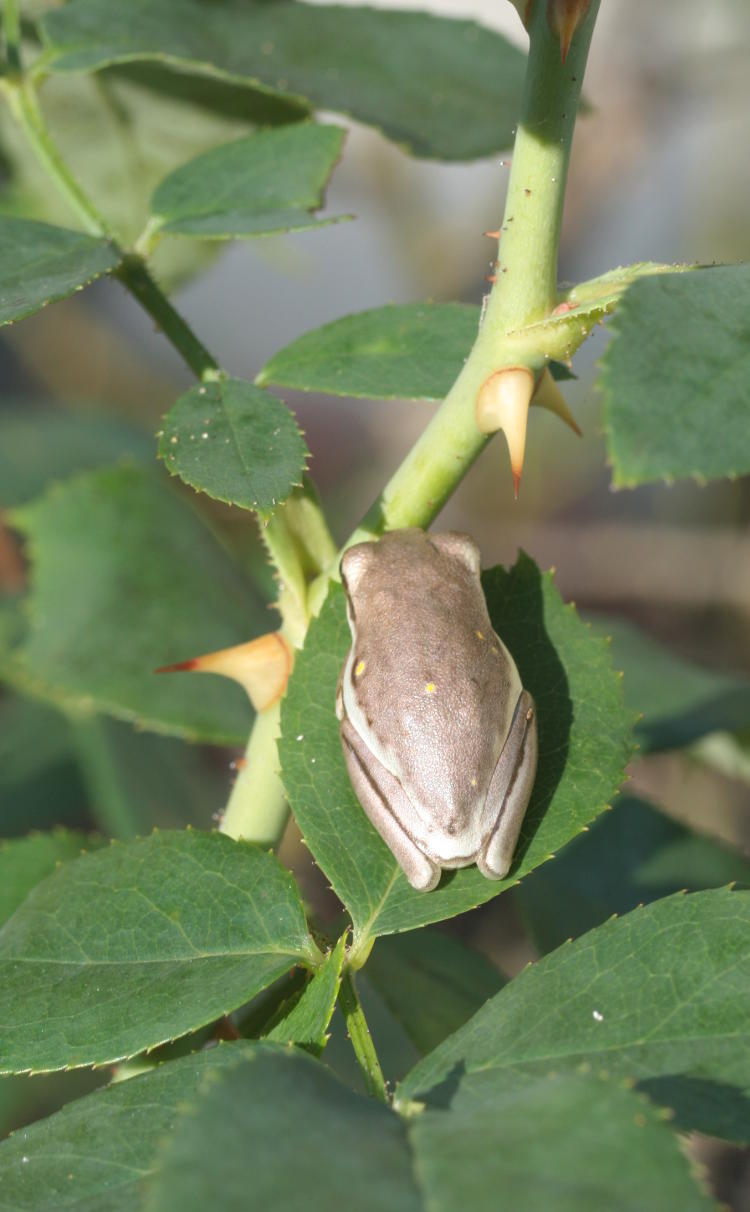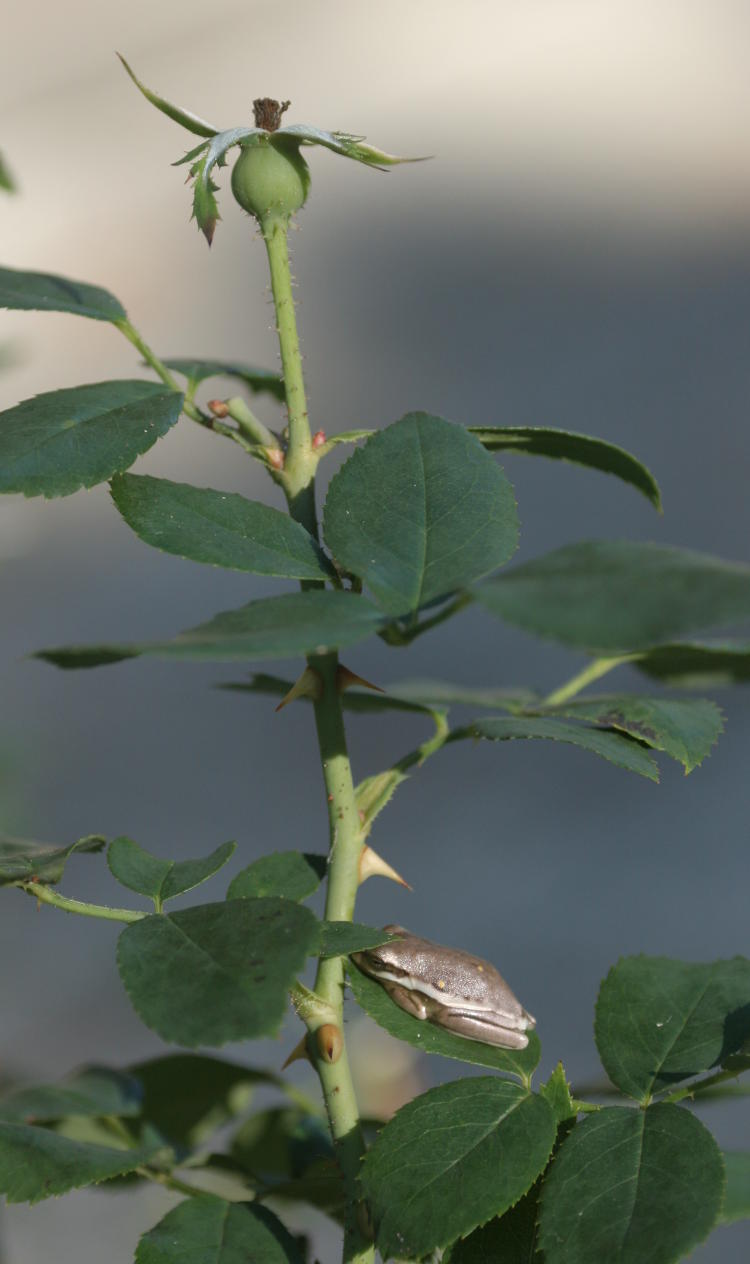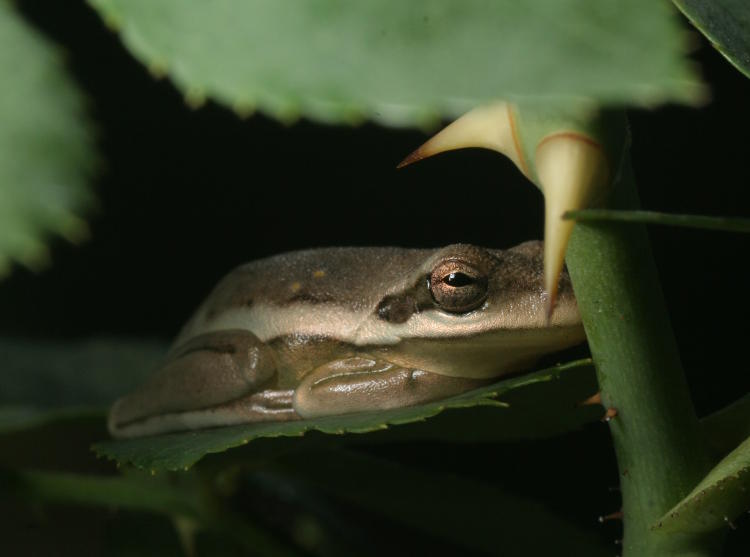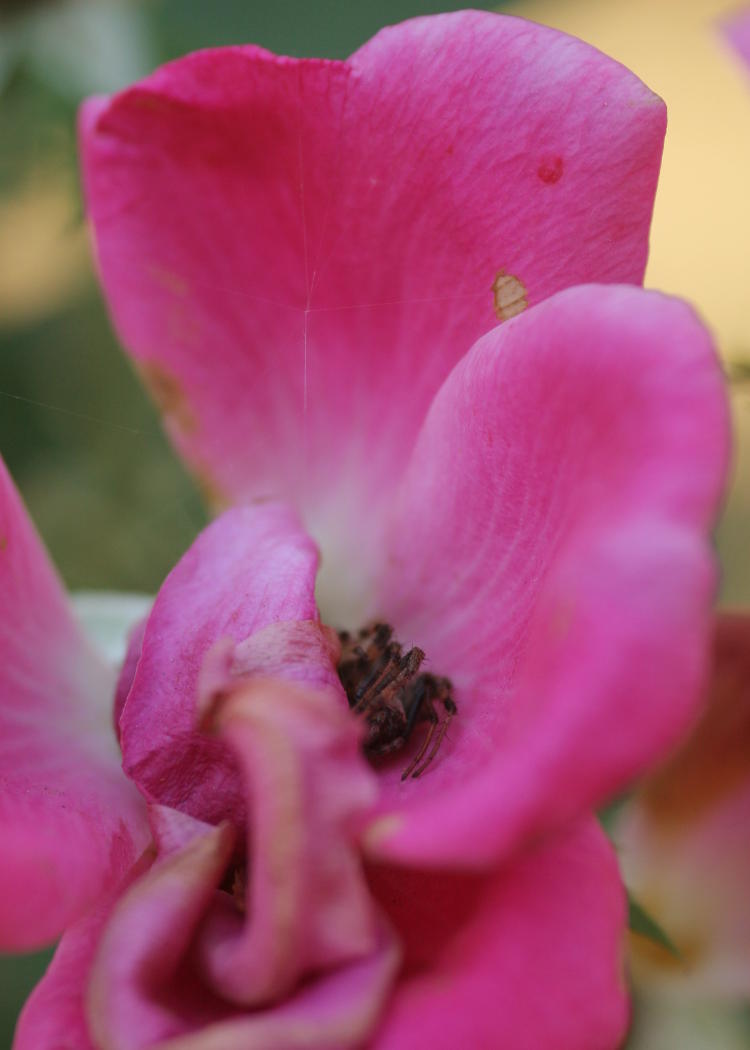So, there’s a small benefit to backyard photography, aided by blogging about it, and it’s this: you have the opportunity to see if there is a long-term pattern that develops among the common species, and even pin down exact dates. It doesn’t necessarily tell you why there seems to be a pattern, however…

There’s a large and hearty rosebush that sits alongside the mailboxes at the end of our driveway, and when I went out to get the mail yesterday I spotted a little anachronism on top of a leaf, which is how I find far too many of my photo subjects; the pattern of leaves was broken by something that was not leaflike. This one was silvery-grey in color, and initially I thought that I’d found the egg case of a Carolina mantis, but a closer look immediately dispelled this stupendous mistake since I recognized it as a treefrog. Despite the color, this was not the common Copes grey treefrog, but a juvenile green treefrog (Hyla cinerea) instead.

Given that the overall length of the frog in this position was less than 30mm, which is about the length (and shape) of a Carolina mantis egg case, I think I can be forgiven, but we’ll have to check with the pope of nature photographers for the official ruling. And of course they’re not usually silvery grey (green treefrogs I mean, not the pope who actually is,) but the white stripe down the body identifies this pretty solidly, since the grey species lacks it. While the temperatures have dropped a bit now from the sweltering summer months, this guy was still out in direct sunlight, which was also curious – they usually avoid it, but this could have been intentional warming in late afternoon before going out on its nocturnal hunt that evening.

As for the color, I can’t answer that right at the moment – it didn’t blend in very well with the leaves, but it was a pretty solid match for the heavier stems just a few centimeters away, and I honestly don’t know how quickly they can change their coloration. I’ve seen them in a variety of green hues, but not grey, until now. The drought that we just came out of might have had something to do with it as well, but I’m only speculating until I spend a little time in research, which is not happening right at this moment.

Switching from ambient light to macro flash changed the appearances, of both the frog and the background, to some degree – I actually like the ambient light version better this time around, but the flash unit is often necessary to bring out details better (allowing a smaller aperture for greater depth,) and of course when I usually find them at night.
I remarked upon a pattern, and I’ve seen it for a few years running now: the treefrogs disappear in late summer, almost unable to be found, but make a reappearance as the weather turns colder. Again, only speculation, but I think that, in spring and early summer, they emerge from hibernation and begin the mating cycle, keeping them within easy reach of a water source to deposit eggs, but then move higher into the treetops for the hotter months. As the temperature starts dropping, they come back down to ground level to find a spot to burrow into for the winter months. Seems to coincide with the temperature changes, anyway.

While I had the flash unit fired up, I had to go for my portrait angle, or the best I could achieve given the frog’s position close to the stem. And you gotta love those little legs tucked in that way – I really need to do a carving of this someday.
The change might also have been due to finally getting some decent rain for the first time in weeks, though I don’t know where the treefrogs might be when it’s too dry – you’d think they’d be close to water sources like the rainbarrels and backyard pond, yet no signs of them were to be found the past few weeks, so this might not be a valid thought (but that goes without saying – my edumucation is not, shall we say, extensive.)
The rosebush has been showing the signs of the drought recently, as slightly evidenced by the wider pic further up – all of the blossoms had disappeared, even though it hasn’t been cold enough to foster the winter ‘dead’ appearance yet. A few weeks back they’d still been present, as shown by a grab pic that I’d snapped then, which I include now just for comparison and because I’ve been slack on spider images and I know you’re all getting kinda antsy about that.

Yes, that’s a spider hiding deep within the blossom, unidentified but fairly likely a barn spider, which are common here and prone to hiding during daylight before spinning a large orb web at night. I just liked how well the camouflage worked despite it being in about the highest contrast position it could have achieved.
Oh, and one more shot just for giggles, back to yesterday, taken as I returned to the house. The aforementioned kitten is still around.

Believe me, this is not at all indicative of her personality. We went through various names suggestive of her nature – referring to the beans she was obviously full of, to naming her after pistols, and some attempts to find the name of a silent film star since she doesn’t meow audibly at all – before we finally settled on “Taz,” given her whirlwind activity several times a day and her monstrous nature. More about her later on.




















































